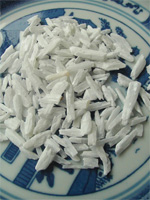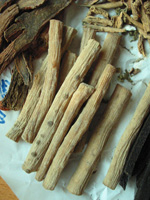有關中草藥基礎問答
- What are Chinese medicines made out of?
- What is the usual preparations for Chinese herbs?
- What are the “four natures” and “five flavors” of Chinese herbs?
- What are the ascending, descending, floating and sinking effects of Chinese herbs?
- What is meant by applying herbs according to the meridians?
- How are herbs selected and combined for remedies?
- What are guiding herbs? How do they work in prescriptions?
- Why are Chinese herbs processed in various ways?
- How to identify the quality of Chinese medicinal materials?
- How to store Chinese herbs?
Q : What are Chinese medicinal materials composed of?
 A: Any type of material can be a Chinese medicine. However, plants (herbs) make up the bulk of prescriptions, followed by animal products and then minerals. Plants cover whole grasses, roots, stems, leaves, flowers, barks and fruits. Animal products consist of insects, fishes, shells, worms and animal parts, while minerals include gypsum, realgar, and sulphur etc.
A: Any type of material can be a Chinese medicine. However, plants (herbs) make up the bulk of prescriptions, followed by animal products and then minerals. Plants cover whole grasses, roots, stems, leaves, flowers, barks and fruits. Animal products consist of insects, fishes, shells, worms and animal parts, while minerals include gypsum, realgar, and sulphur etc.Q : What is the usual preparations for Chinese herbs?
A: Chinese medicinal materials refer to the drugs used under the guidance of Chinese medical theory; any substance can become a Chinese medicinal material.
Q : Chinese medicinal materials have how many types?
A: According to the data from the National Chinese Medicine Resources Census Information Management System, there are currently about 13000 species of wild medicinal resources in China, more than 700 species of artificially cultivated medicinal materials, and nearly 1,900 species of medicinal materials circulating in the market. The more commonly used Chinese medicinal materials are about 400 species.
Q : What are the usual dosage forms in Chinese herbal remedies?
A: Traditionally, physicians suggest their patients to boil their prescriptions with water to make a soup for consumption, the so-called decoction. In addition to the form of decoction, there are other different preparing forms, such as traditional bolus, powders, ointments, pellets, and modern capsules, tablets, granules, syrups and even injections, which are in wide variety to meet the health needs of people.
Q : What are “Four Natures” and “Five Flavors” in Chinese medicines?
A: The “Four Natures” refer to the four medicinal properties of cold, cool, warm, and hot, and the “Five Flavors” are sour, bitter, sweet, pungent, and salty. These medicinal properties of Chinese medicines are summarized by the ancients based on the different reactions that appear after the medicines acted on the human body. For example, when people experience heat symptoms such as dry throat, constipation, and yellow urine, they can be relieved by taking herbs like golden thread rhizome and Chinese rhubarb, indicating that these herbs are cold or cool in property. If someone experience chills, fever, runny nose, and body aches that present a wind-cold syndrome, herbs like notopterygium root and ginger can relieve the signs, and therefore the herb can exert a warm and hot property. As for the Five Flavors, they will have different effects, for example, pungent herbs such as fresh ginger and onion have a sweating effect, sweet herbs such as red dates and pilose asiabell root have a tonic effect.
Since the Chinese medicines have different natures, flavors and attributions, which help evaluate their clinical actions, and so can be classified accordingly.
Q : What are Ascending, Descending, Floating, and Sinking effects in Chinese medicines?
A: These different "spatial" effects reflect the action tendencies of Chinese medicines.  |
 |
 |
 |
| Ascending effect | Descending effect | Floating effect | Sinking effect |
Q : What is meant by applying herbs according to the meridians?
A: Applying herbs according to meridians is to demonstrate the position where the herbs will have the most effect on. Chinese herbs are grouped according to their energetic properties, meridians in here mean the different organs that are linked by the energetic channels. Q : How are herbs selected and combined for TCM prescriptions?
A: In TCM, herbal therapies are generally formula based and single herbs are rarely used. TCM holds that every medicinal substance has its strengths and its shortcomings, and each ingredient in the formula should be carefully balanced in quality and quantity, in order to accentuate its efficacy while reducing side effects.
- Mutual Need (相須): This refers to the combination of herbs with similar properties and effects to enhance the original therapeutic effects. For example, when anemarrhena rhizome and gypsum are used together, their effects of heat-clearing or fire-purging are significantly enhanced.
- Mutual Enhancement (相使): This refers to the combination of herbs with the same or different properties, one as the main herb and the other as the adjuvant, to enhance the efficacy of the main herb. For example, when golden thread rhizome is used to treat dysentery, costus root can assist by smoothing bowel movements and arresting abdominal pain.
- Mutual Counteraction (相殺): This refers to one herb being able to reduce or eliminate the toxic side effects of another herb. For example, mung beans can kill the toxicity of croton.
- Mutual Restraint (相畏): This refers to when two herbs are used together, the toxicity or efficacy of one herb is inhibited by another. For example, pinellia and arisaema are restrained by fresh ginger.
- Mutual Antagonism (相惡): This refers to when two herbs are used together, one herb weakens the original effect of another herb, such as the invigoration effect of ginseng can be inhibited by radish seed, fresh ginger reduces the effects of baical skullcap root.
- Mutual Inhibition (相反): This refers to when two herbs are used together, they produce strong side effects; for example, liquorice root will increase the toxicity of lilac daphne flower bud.
- Single Use (單行): This refers to a herb used alone in order to exert its own specific action, e.g. ginseng alone is enough to replenish inborn qi in a short time.
Q : What are guiding herbs? How do they work in TCM prescriptions?
 A: A guiding herb is used to enhance overall efficacy of the prescription, harmonize actions between ingredients, reduce toxicity or harshness, correct taste, or enable other ingredients to work on specific meridians.
A: A guiding herb is used to enhance overall efficacy of the prescription, harmonize actions between ingredients, reduce toxicity or harshness, correct taste, or enable other ingredients to work on specific meridians.- Harmonize and enhance the actions: For example, in wind-heat type influenza when individuals present with a high fever and thirst, bamboo leaf and reed rhizome are used. The two herbs work together can strengthen the effects of clearing heat and bringing down the fever.
- Guide other herbs to work on specific meridians: For example, pain in the lower limbs and feet, achyranthes root is usually selected to act as a guiding role, so that other herbal effects travel to the painful location.
- Reduce toxicity insect is very toxic, mung beans would also be used as the guiding herb to prevent harmful effects from occurring.
- Improve taste: For example, the fishy smell of some animal products can be eliminated by millet wine. Ingredients like honey, malt sugar and sugar cane juice are often used to make herbs more palatable.
Q : Why are Chinese herbs processed in various ways?
A: Chinese herbs are processed in such a way to:- Reduce / eliminate toxicity and side effects;
- Alter or improve the properties of herbs, so as to enhance healing effects;
- Alter or reinforce the properties of herbs, so that they can work on specific body parts and action tendencies;
- Facilitate mixing with other herbs so that they can be made into different forms;
- Maintain the purity of the medicinal materials;
- Facilitate storage and aid consumption.
Q : How to identify the quality of Chinese medicinal materials?
A: Due to differences in growing environment and the nature of the soil, there are big differences in the effective ingredients of plants used as TCM, and also differences in quality. Generally speaking, medicinal materials which are grown in the wild and from well-known areas are considered to be of better quality than those that are cultivated. Furthermore, the size, shape, color, texture and flavor of medicinal materials are factors determining the quality of Chinese herbs. To ensure that you buy high quality herbs, please purchase Chinese herbs from creditable herbal pharmacies.Q : How to store Chinese herbs?
A: If Chinese herbs are not stored properly, their effectiveness could become compromised. This is indicated by certain physical changes, like changes in color and flavor. Worm infestation and molded can also occur if the herbs have been stored in relatively high room temperatures and humidity (>70%), or when the herbs or herbal products have a relatively higher water content. In such a situation, medicinal materials could also lose their essential oils and become "greasy look". In order to keep your Chinese herbs from deteriorating, place it in a dry, well-ventilated and dark environment. Ideally, storage in a cool place will lessen the likelihood of molded or pest infestation occurring. Written by:
CM Promotion Group - School of Chinese Medicine, CUHK.References:
Chinese Pharmaceutics Chinese Pharmaceutics Identification Published by Shanghai Science and Technology Publishing House, 6th edition.Translated and Edited by:
Jennifer Eagleton, BA, MA (Asian Studies), Integrated Chinese Medicine Holdings Ltd. Lawrence Lau, Ph.D., Integrated Chinese Medicine Holdings Ltd.
Rose Tse, Integrated Chinese Medicine Holdings Ltd.


